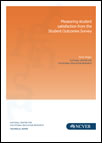Description
The Student Outcomes Survey is an annual national survey of vocational education and training (VET) students. Since 1995, participants have been asked to rate their satisfaction with different aspects of their training, grouped under three main themes: teaching, assessment, and general skills and learning experiences. In this paper we review and compare three different methods of creating summary measures — Rasch analysis, weighted means and simple means — that encapsulate the three main themes of student satisfaction. We find that all three methods yield similar results and so recommend using the simple means method to create the summary measures.Summary
About the research
The Student Outcomes Survey is an annual national survey of vocational education and training (VET) students. Since 1995, participants have been asked to rate their satisfaction with different aspects of their training, grouped under three main themes: teaching, assessment, and generic skills and learning experiences. While the composition of the bank of satisfaction questions has remained fairly constant over time and the suitability of the three overarching satisfaction categories has been validated statistically on several occasions, little progress has been made on creating summary measures that encapsulate the three main themes of student satisfaction. Such summary measures would be much more useful to researchers than responses to the bank of 19 satisfaction questions, which are very detailed. This paper compares three methods of creating a composite score and evaluates their statistical veracity.
Key messages
-
The grouping of satisfaction questions into themes of teaching, assessment, and generic skills and learning experiences remains statistically valid in the current Student Outcomes Survey.
-
A composite score for questions under these three main themes is needed to facilitate post-survey analytical studies.
-
We review and compare three different methods of creating summary measures in respect of their utility. These methods are Rasch analysis, weighted means and simple means.
-
We find that all three methods yield similar results and so recommend using the simple means method to create the summary measures.
Tom Karmel
Managing Director, NCVER
